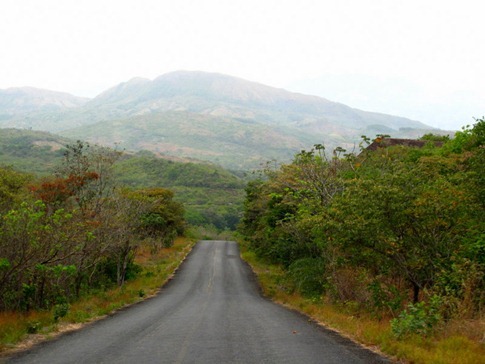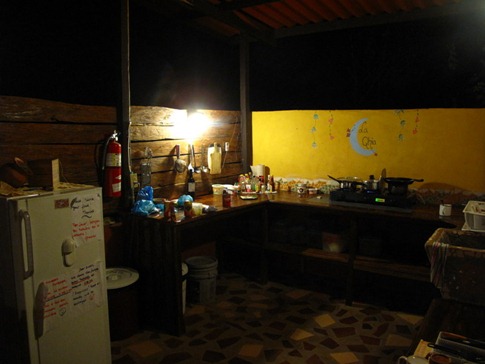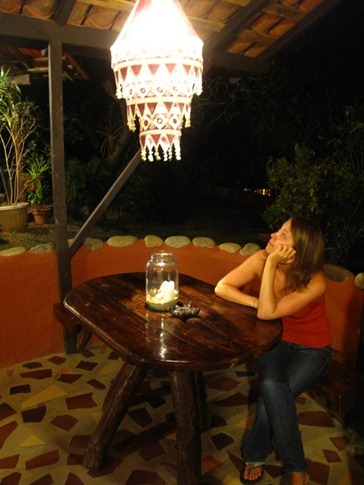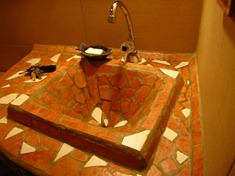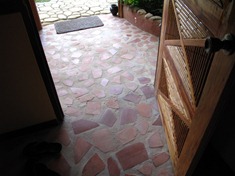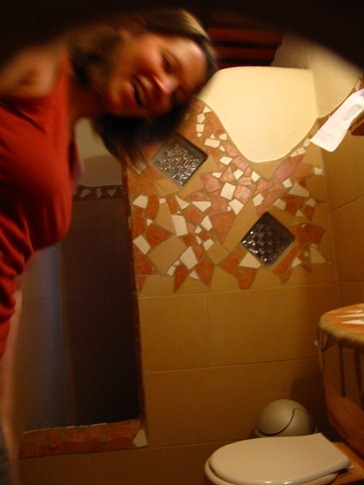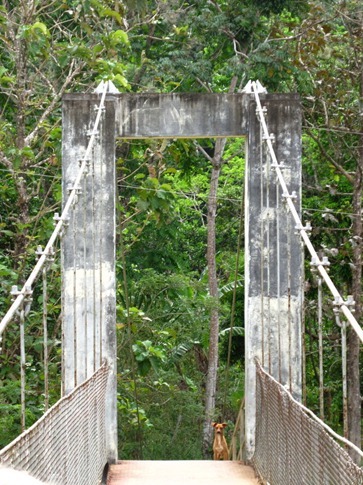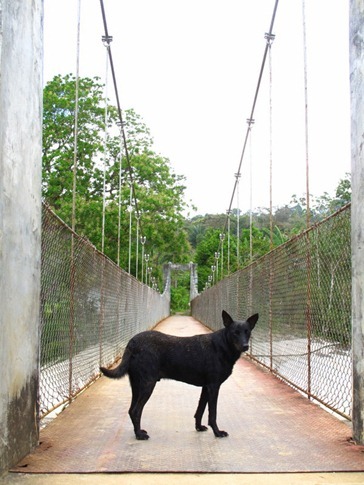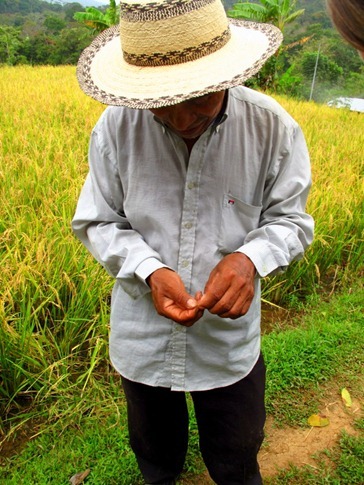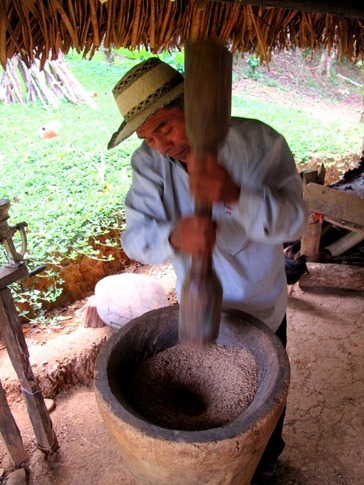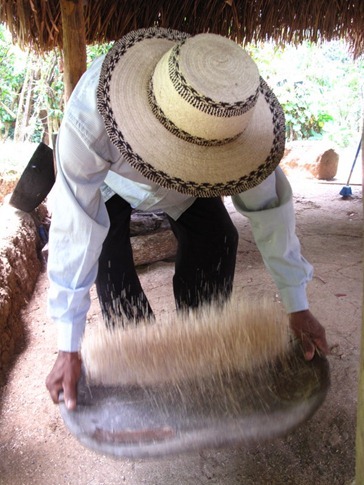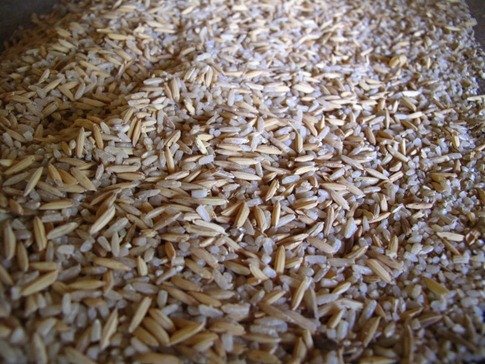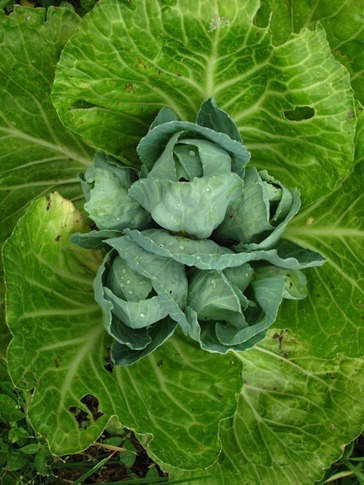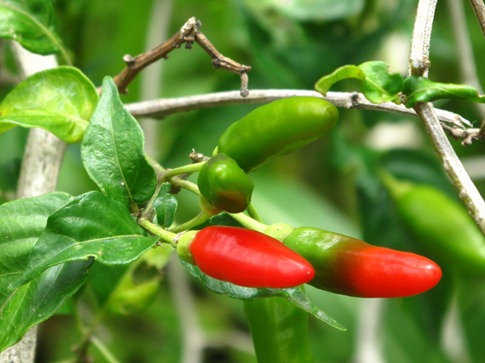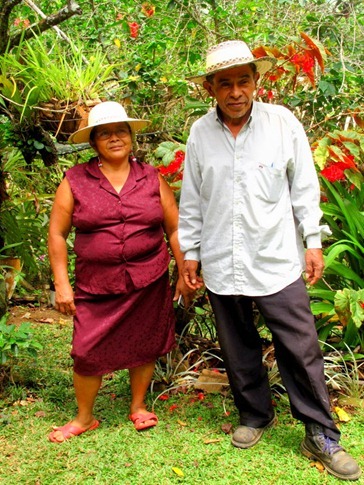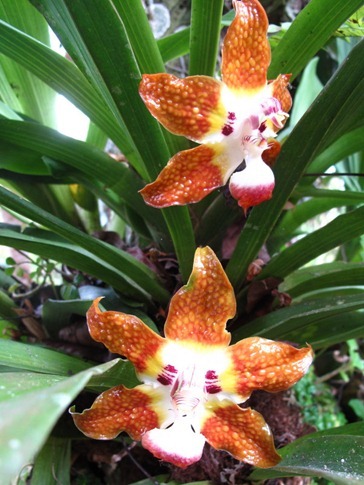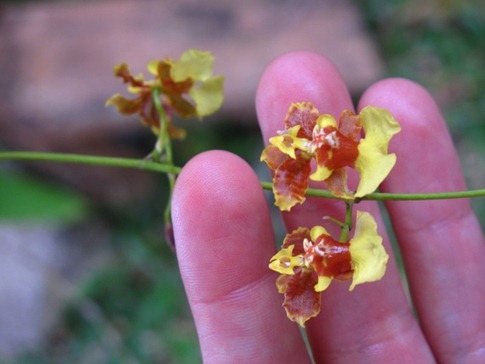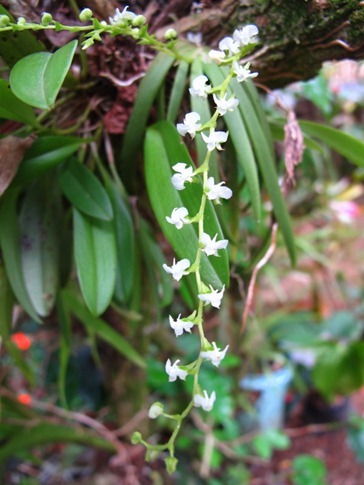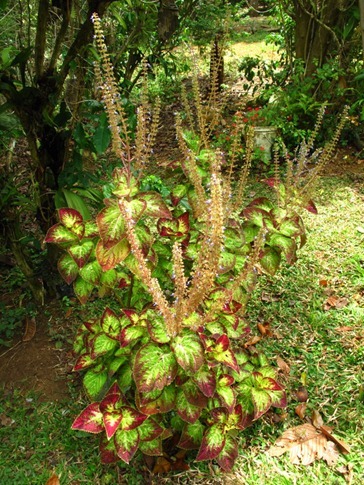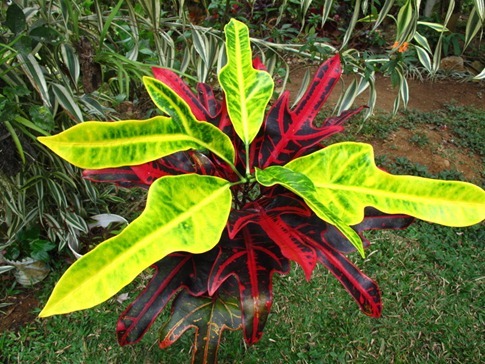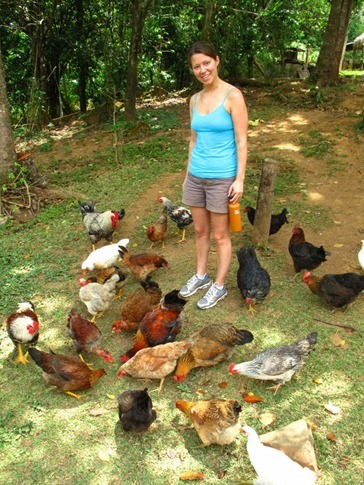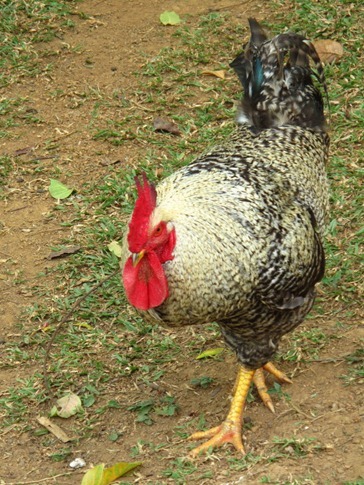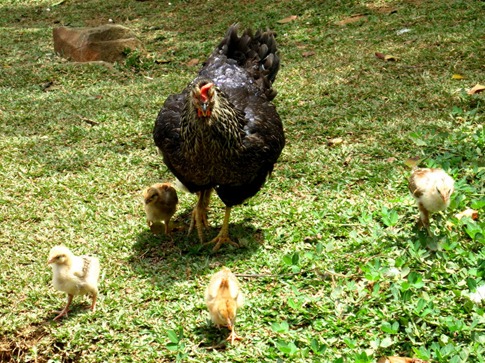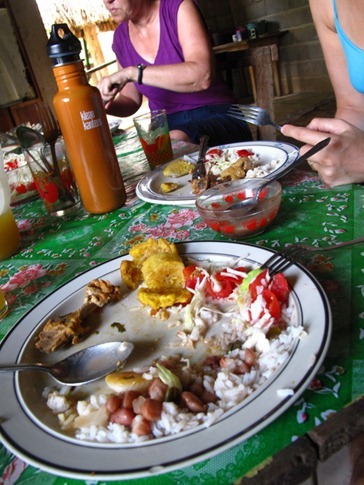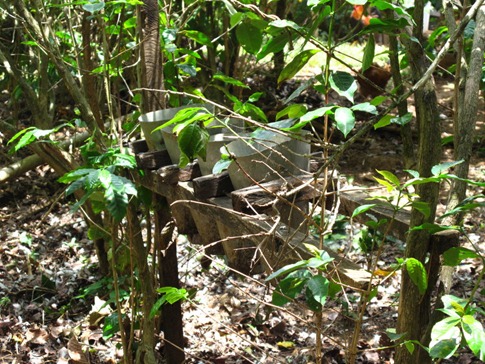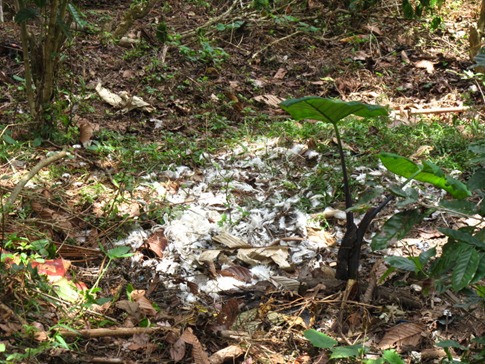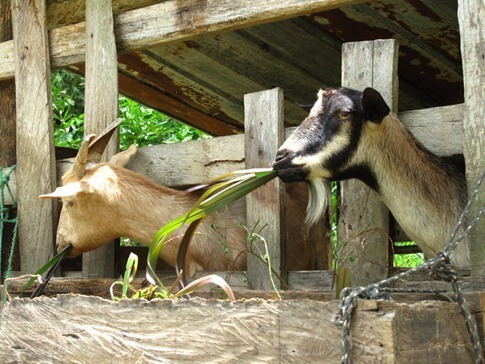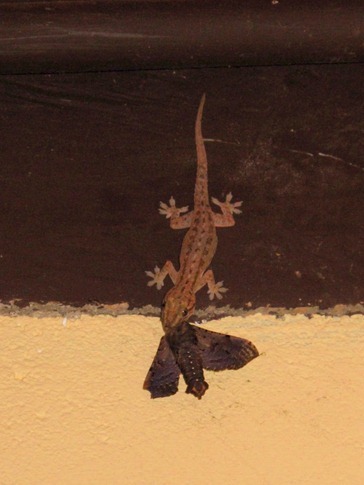The Panamerican Highway runs pretty much West-East across the lower two thirds of Panama with cutoffs running up into the mountains or down to the beaches; Bocas del Toro in the the northwest corner is one of the only beaches accessible on the Caribbean side. While the pictures we’ve seen of the coasts are pretty spectacular, it was the cool air of the mountain towns that called to us.
Road signs in Panama started out promising, listing precise distances to far off destinations, although one starts to question their objectivity when a prominent logo for a large rental car or hotel chain appears at the top of each. And if a small farm town like Santa Fe doesn’t happen to have a Best Western, good luck finding the turn off without a GPS.
Equipped with our new Panama Lonely Planet, we wound through the small country lanes of Santa Fe looking for the Hostal La Qhia. Where we thought it was on the map, we saw a run down house with a small front yard and some dilapidated doors hanging off the hinges along the side. See? This is why I always cringe when I see the word “hostal.” I immediately think “hostile.”
But as we continued up the road to turn around, we found the real entrance, a pretty gate leading into a grassy driveway. In front was a large, rustic house overlooking a flowing landscape of rock-fringed plantings. To the side were an open air palapa structure with hammocks and retro café tables and a row of brightly painted guest rooms attached to an outdoor kitchen. When we checked out a room, it was clean with nice decorations and a big comfy bed. The bathroom was done in a really cool mosaic of broken tiles that tied into the polished cement floor. Now this is what I call a hostal. With no real idea of what there was to do in Santa Fe but also no timeline for Panama, we immediately started talking about spending two nights there.
While long hikes to waterfalls seem to be the main attraction of the village, we’d become a little obsessed with the idea of small, self-sufficient farms, and the next day, found one we could take a tour of. Apparently a gringo woman had befriended this farmer and mentioned that tourists might be interested in seeing his land and lifestyle. She connected him with the hostal, and we drove 10 minutes outside of town where he met us along the side of the road for the 15 minute walk into his property.
We found out later that he’d gotten this land about 50 years ago after a priest had come to the area to organize the locals who had been primarily working for European landowners. When the Italian who had owned it before died, the property was divided among 12 local families who have farmed it since then, selling anything extra they grow at a coop in town.
Our first stop was a 40 foot square plot of rice. I don’t think I’d ever seen rice grown up close. He explained in Spanish that he floods the field – is it a paddy? – at certain times using a gravity fed water supply at the top of the hill above. When the rice is ready for harvest, the top portion is cut off and loaded into baskets. Like the coffee beans we’d learned about in Orosi, the rice kernels have a paperlike sheath that is removed with thrashing process in what looks like a giant mortar and pestle. Then, with the rice on an oblong wooden platter, a flick of the wrist sends the sheath flying while the rice remains. Think of that next time you rip open a box of Uncle Ben’s.
Alongside the rice field, were scattered planting areas with lettuce, peppers, tomatoes and various fruits. He clearly knew where everything was but we had to watch our step to be sure we walking walking through a row of something unidentifiable.
Up at the house, the farmer’s wife took us on a tour of her orchid garden, filled with specimens she’d collected about a half day’s walk up into the jungle behind their house after heavy winds had blown them out of the trees.
You can’t help but wonder about the evolutionary process that selected flowers of these shapes and sizes to prosper.
And some colorful non-orchids.
Why do some of these plants make me want to giggle?
Having agreed that we at some point needed to own a greenhouse, we moved on to another future necessity: chickens! We’ve had friends who have had chickens before and had always thought it was great – for them. But in our current state of bordering-on-obsession with the idea of returning home and moving somewhere with enough space that we could have a mini-farm, plant a big garden and orchard and raise a couple animals, chickens are a no-brainer.
While later that night I would find myself researching chicken coop designs and thinking about reverse engineering fancy ones like these I found on a friend’s homesteading blog, when we asked the farmer where his chickens slept, he just kinda shrugged and said he didn’t know, in the trees he guessed.
Chickens are another fascinating evolutionary example; They really are beautiful, at least the ones who haven’t had their feathers pecked out by the others. Is it possible that farmers have a tendency to pick the less attractive ones for lunch, preserving the blood lines of the more extravagant? Well, it was hard to tell what the one on our plates at lunch had looked like…
We’d been reading a lot about “farm chicken” having a very different taste and texture than what we’re used to getting in the grocery store, and it was true. This meat had much more integrity, pulling apart in sinews rather than cutting uniformly into consistent cubes. We wondered how we’d feel eating it after having just seen the birds outside happily pecking and scratching, but it actually felt good to be a little closer to the source, to take some responsibility for eating meat.
And sure enough, along the path out to see the goats, we came across the cones where the chickens are placed head first before their necks are slit and a pile of feathers that likely belonged to our lunch. It’s graphic stuff, but would you rather eat a chicken that’s been bred to have breast so big it can’t stand up and lived crammed into a dark building with 20,000, some alive some dead, other birds? This is obviously something we’ve been thinking about a lot lately. We like the idea often credited to Michael Pollan, author of “The Omnivore’s Dilemma,” that animals should live “a happy life with one bad day.”
Unfortunately, the goats didn’t seem to be having such a happy life, caged in a pen. We had to hold our tongues, realizing that the utopian, symbiotic, idyllic farm life we envisioned was a luxury that didn’t take into consideration the immediate needs of feeding one’s family and the concessions one might need to make under those circumstances.
Back at the hostal, the circle of life continued as the geckos scaled the walls in search of mosquitos and moths.
Panama was moving fast. El Valle, a few hours away, would likely be our last stop before Panama City. We’d been thinking a lot about being home, not because we were excited to end the trip, but because we were ready to start the next phase of our lives. While we’d set out on this adventure to expose ourselves to new cultures and to have a big adventure, really our goal was to clear our minds enough to be open to doing just about anything when we got back. For us, travel was never the lifestyle we wanted, only a means of exploring our priorities and values, discovering new things and realizing what we missed and didn’t miss. And having seen a lot of things and had experiences, good and bad, we were starting to form a pretty good idea of the life we wanted to create at home.

